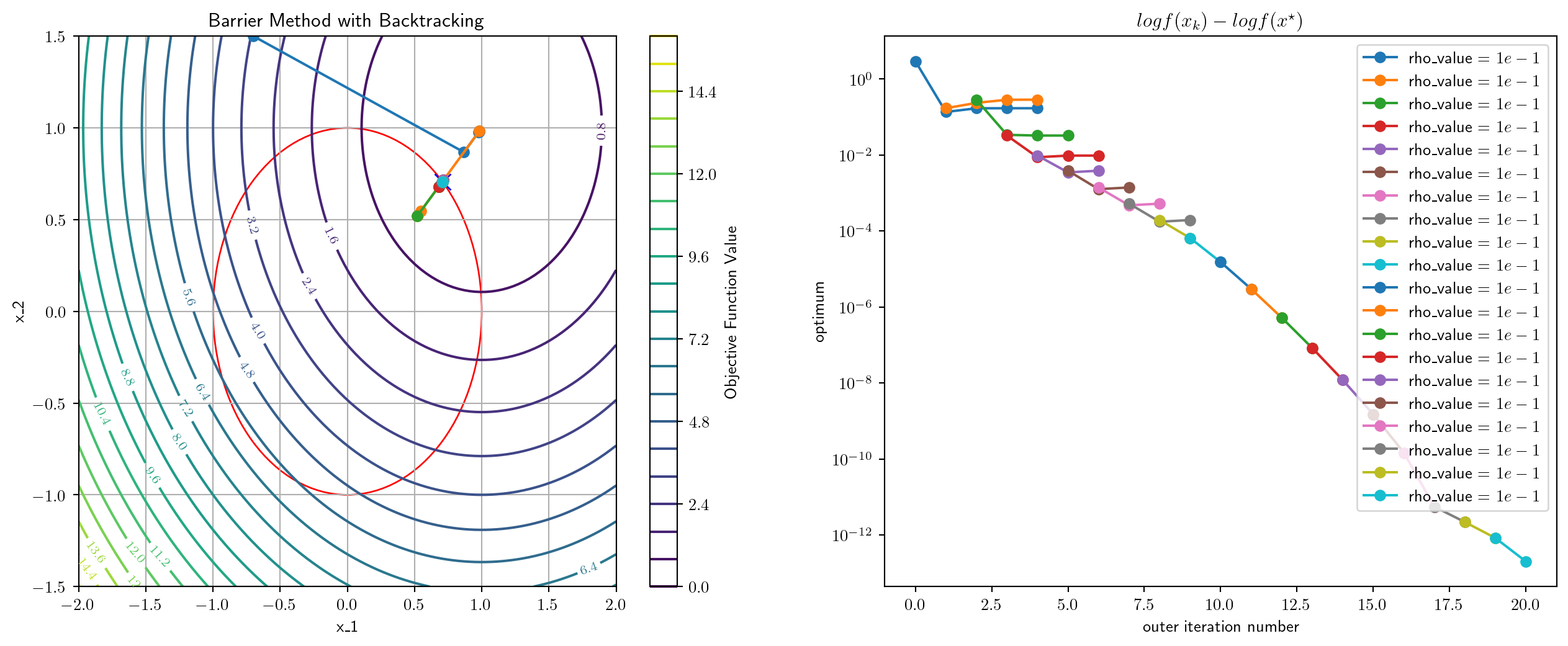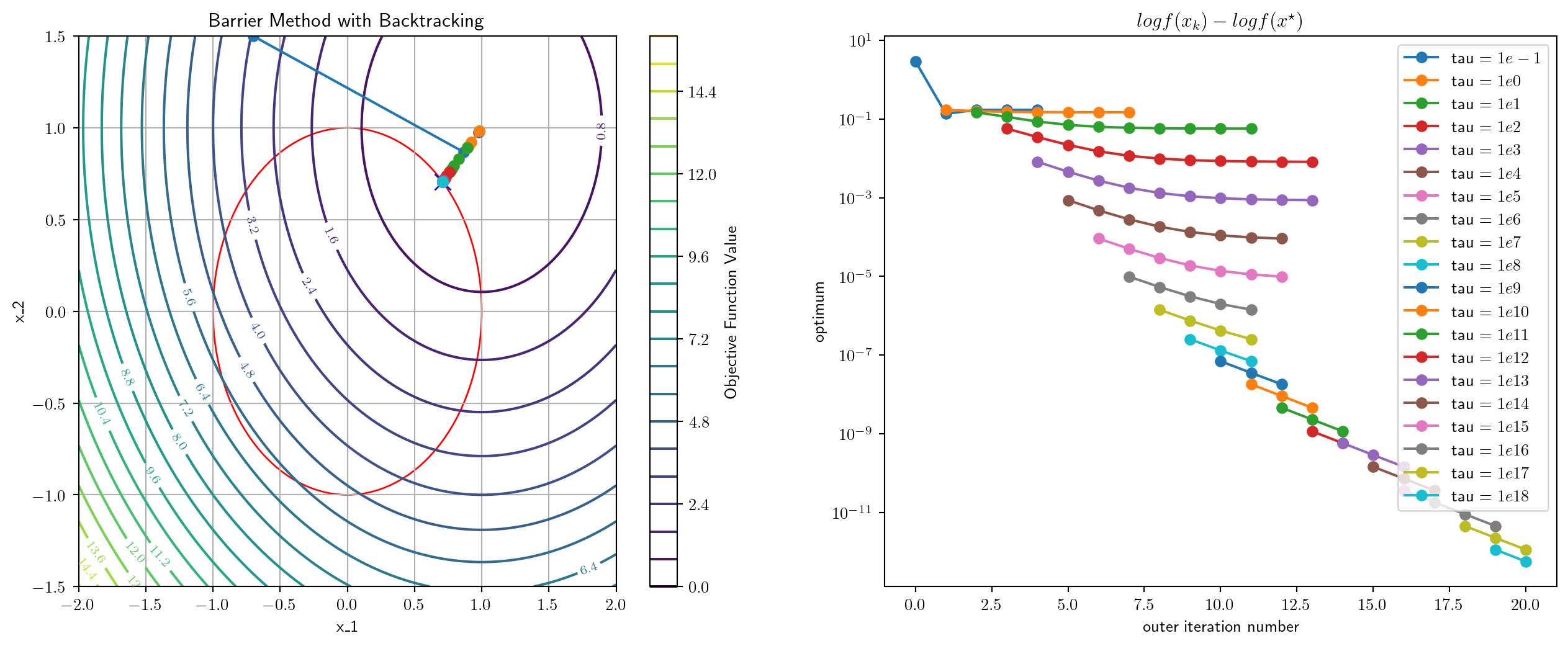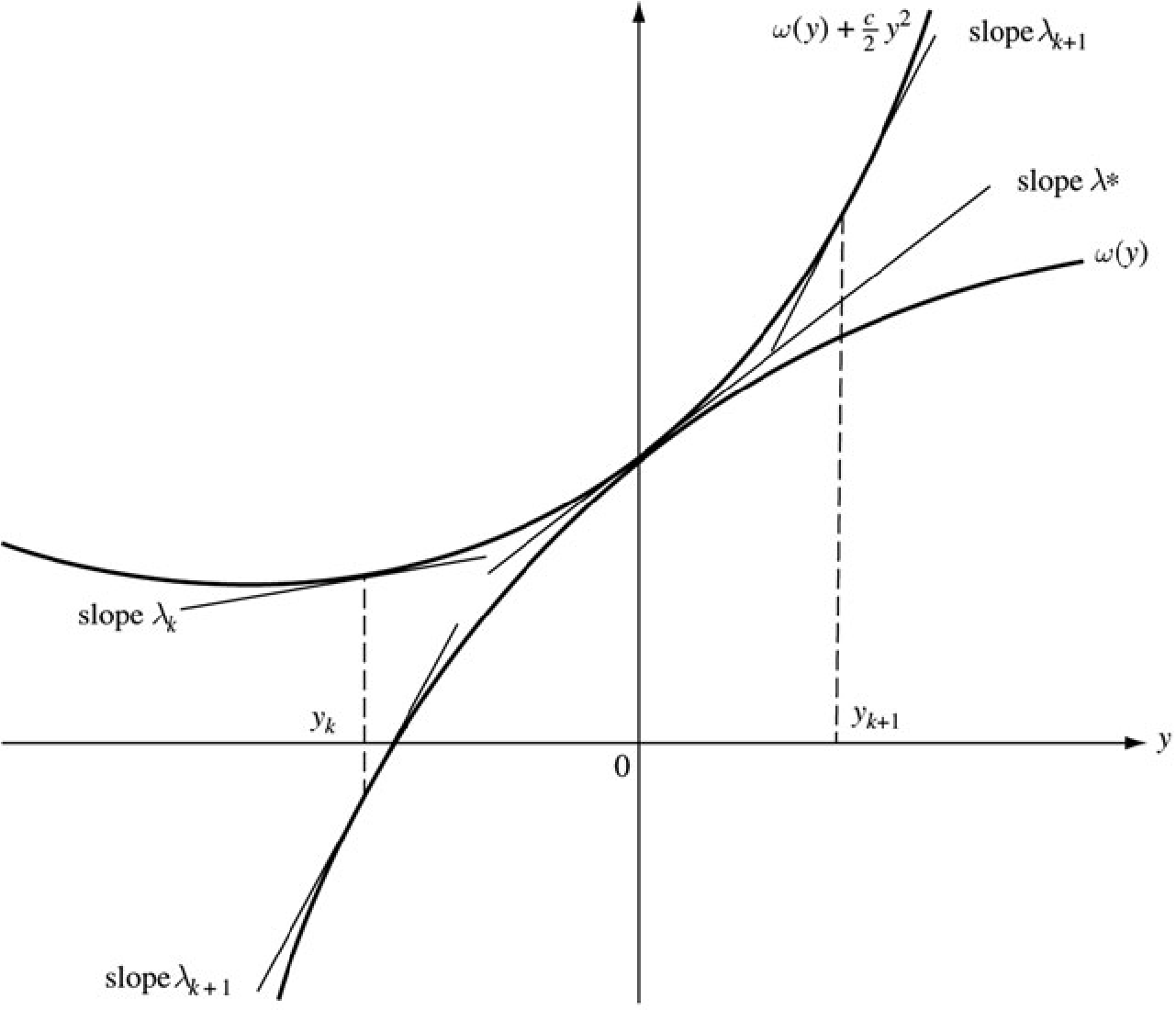0.5199909210205078 msec elapsed for NM
[0.70710678 0.70710678]
Instructor: Hasan A. Poonawala
Mechanical and Aerospace Engineering
University of Kentucky, Lexington, KY, USA
Topics:
Dual function and problem
Examples
Local Duality
Sensitivity
Primal Optimization problem:
Introduce the Lagrangian associated with the problem, defined as
Let then
Take the infimum of both sides
Dual function
Lower bound property
for any dual feasible pair
Dual feasibility
The pair is dual feasible if and
Dual optimization problem
Dual optimization problem
Convexity of the dual
The dual problem is a convex optimization problem
Proof
By definition, is the pointwise infimum of affine functions of , and is therefore concave. is an affine constraint. Hence, the dual problem is maximization of a concave function with affine constraints, which is a convex optimization problem.
Let
Clearly,
For convex problems that satisfy appropriate conditions, like Slater’s conditions1,
Generally, the duality gap is , which is non-negative
When is feasible, the lower bound property can be rewritten as
and the supremum is achieved when
Therefore
By weak duality,
and under strong duality:
In turn, , where 1
We can simplify the problem to
Define
This function is convex in (but not in all variables), with minimum given by the FONC:
Therefore, the dual of the SVM problem is:
Eliminating , we get the following dual SVM problem:
Maximal flow problem
Determine the maximal flow that can be established in such a network.
where for those no-arc pairs .

Linear Program (LP)
An LP is an optimization problem in which the objective function is linear in the unknowns and the constraints consist of linear (in)equalities.
Symmetric form primal LP
Determine the most economical diet that satisfies the basic minimum nutritional requirements for good health
We want to minimize the total cost
subject to the nutritional constraints
and the nonnegative constraints on the food quantities.
We wish to manufacture products at maximum revenue
subject to the resource constraints
| Primal | Dual | |||
|---|---|---|---|---|
| subject to | subject to | |||
If is an matrix, then is an -vector, is an -vector, is an vector, and is an -vector.
The vector is the variable of the primal program, and is the variable of the dual program.
Important
The roles of the primal and the dual can be reversed!
Multiplying the objective and the constraints by minus unity, the dual has the structure of the primal.
Its corresponding dual will be equivalent to the original primal.
Primal LP (Standard Form LP)
Conversion to dual (Inequality Form LP)
Partition the dual vector as , we get
Letting , this is simplified as
The dual of the dual is the primal!
| Primal/Dual | Dual/Primal | |
|---|---|---|
| Obj. coef. vector | | | Right-hand-side |
| Right-hand-side | | | Obj. coef. vector |
| | | ||
| Max model | | | Min model |
| | | constraint sense: | |
| | | constraint sense: | |
| free | | | constraint sense: |
| constraint sense: | | | |
| constraint sense: | | | |
| constraint sense: | | | free |
Throughout this section, we consider the primal-dual pair
Weak Duality Lemma
If and are feasible for the primal-dual pair, then .
Proof
We have the last inequality being valid sincd and .
Corollary
If and are feasible for the primal-dual pair and if , then and are optimal for their respective problems.

Duality Theorem of LP
If either of the primal-dual pair problems has a finite optimal solution, so does the other, and the corresponding values of the objective functions are equal. If either problem has an unbounded objective, the other problem has no feasible solution.
Proof
Firstly, the second statement is an immediate consequence of weak duality. If the primal is unbounded and is feasible for the dual, we must have for arbitrarily large , which is clearly impossible.
Let us assume that the primal has a finite optimal solution and show that the dual has a solution with the same value (recall primal/dual are reversible). We prove that if the primal problem is feasible and its minimal value is bounded from below, then the system
has a feasible solution pair and . The first system in Equation 2 is the primal constraint system, the second is the dual constraint system, and the third is the reversed duality gap, which, together with weak duality, implies zero-duality gap .
Proof - Continued -
We first show that the dual must be feasible, since otherwise, from Farkas’s lemma the alternative system to the second system Equation 2 must be feasible, that is, there is such that . Let be any given feasible solution for the primal, then the solution must also be feasible for the primal for any scalar . But the primal objective value at this solution is which is unbounded from below as leading to a contradiction.
Now, both the primal and the dual are feasible but suppose their optimal values are not equal; that is, the whole system Equation 2 remains infeasible. Then its alternative system must be feasible. That is, there are to satisfy the constraints
Case 1: in Equation 3, then we have which is a contradiction.
Case 2: in Equation 3, then we let be any feasible solution for the primal and be any feasible solution for the dual. Again must also be feasible for the primal and must also be feasible for the dual, and the objective gap at this pair is which is not bounded below by as and creates a contradition to weak duality.
Diet Problem
Production Problem
Theorem
The minimal value function of the linear program Equation 1 is a convex function, and the optimal dual solution is a subgradient vector of the function at , written as .
Theorem
The minimal value function of the linear program Equation 1 is a convex function, and the optimal dual solution is a subgradient vector of the function at , written as .
Proof
Let and be two optimal solutions of Equation 1 corresponding to two right-hand-side vectors and , resp. Then, for any scalar , is a feasible solution of Equation 1 with so that the minimal value is
which implies the first claim.
Furthermore, let be the optimal dual solution with . Note that remains feasible for the dual of primal with because the dual feasible region is independent of changes in . Thus
which proves the second claim.
The Lagrange multipliers associated with a constrained minimization problem have an interpretation as prices, similar to the prices in LP.
Let a minimal solution be a regular point and be the corresponding Lagrange multiplier vector. Consider the family of problems
Sensitivity Theorem
Consider the family of problems Equation 4. Suppose that for every in a region containing , its minimizer is continuously differentiable depending on . Let with the corresponding Lagrange multiplier . Then
Sensitivity Theorem
Consider the family of problems Equation 4. Suppose that for every in a region containing , its minimizer is continuously differentiable depending on . Let with the corresponding Lagrange multiplier . Then
Proof
Using the chain rule and taking derivatives with respect to on both sides of
at , we have
On the other hand, using the chain rule and the first-order condition for and the above matrix equality
To solve the dual optimization problem, we need to solve
The dual function is defined using a constrained optimization problem:
Can we replace the inner constrained optimization with unconstrained local optimization?:
where
Local duality answers ‘yes’ in some cases.
Dual Function
First-Order Necessary Conditions
together with the constraint. These equations have a solution at The Hessian of the corresponding Lagrangian is Since this is positive definite, we conclude that the solution obtained is a local minimum (it is, in fact, a global minimum).
Local Duality
Since is positive definite, we can apply the local duality theory near this solution. which leads to valid for . It can be verified that has a local maximum at . Plugging this value back in Equation 8 and maximizing (unconstrained) over and yields the same maximizers as before.
Nonlinear Programming Problem
Everything we do can be easily extended to problems having inequality as well as equality constraints for the price of a somewhat more involved notation.
and the Hessian of the Lagrangian
must be positive semidefinite on the tangent subspace
Local Convexity Assumption
We assume that the Hessian is positive definite. (We mean that on the whole space , not just on the subspace .)
This assumption guarantees that the Lagrangian is locally convex at .
has a solution near when is near because is positive definite.
Thus, locally there is a unique correspondence between and through the solution of the unconstrained problem Equation 8.
Near we define the dual function by the equation
We are then able to show that locally the original constrained problem Equation 8 is equivalent to unconstrained local maximization of the dual function with respect to .
Lemma 1
The dual function has gradient
Proof
We have explicitly from Equation 10 Thus Since the first term on the right vanishes by the defition of (the unique solution to Equation 9), we obtain Equation 11.
Lemma 2
The Hessian of the dual function is
Proof
By Lemma 1, .
Differentiating with respect to , we obtain
Solving for and substituting back to the first equation, we are through.
Local Duality Theorem
Suppose that the problem has a local solution at with corresponding value and Lagrange multiplier . Suppose also that is a regular point of the constraints and that the corresponding Hessian of the Lagrangian is positive definite. Then the dual problem has a local solution at with corresponding value and as the point corresponding to in the definition of .
Proof
It is clear that corresponds to in the definition of . Now at we have by Lemma 1, and by Lemma 2, the Hessian of is negative definite. Thus satisfies the SOSC for an unconstrained maximum point of . The corresponding value is found from the definition of to be .
The modified dual optimization problem is which has the same optimum as the true dual optimization problem, under appropriate conditions.
From Lemma 1, the gradient at is given by the constraint functions evaluated at the optimum of
To solve the modified dual optimization problem we run the following iterations:
Here, is the first-order Lipschitz constant of the dual function .
0.5199909210205078 msec elapsed for NM
[0.70710678 0.70710678]
0.9369850158691406 msec elapsed for NM
[0.70710678 0.70710678]
Lemma
Let and be -by- symmetric matrices. Suppose that is positive semidefinite and is positive definite on the subspace . Then there is a such that for all the matrix is positive definite.
Proof
Suppose to the contrary that for every there were an with such that . The sequence must have a convergent subsequence converging to a limit . Now since , it follows that . It also follows that . However, this contradicts the hypothesis of the lemma.
This lemma applies to the Hessian of the augmented Lagrangian, evaluated at the optimal solution pair , .
This leads directly to the first basic result concerning augmented Lagrangian.
Proposition
Assume that the second-order sufficiency conditions for a local minimum are satisfied at , . Then there is a such that for all , the augmented Lagrangian has a local minimum point at .
where the minimization with respect to is taken to be locally near .

Primal function
where the minimum is understood to be taken locally near .
Then, the augmented Lagrangian function for Equation 14 would be
In contrast to the method of multipliers that we previously covered, the alternating direction method of multipliers (ADMM) is to (approximately) minimize in an alternative order:
Systems Optimization I • ME 647 Home